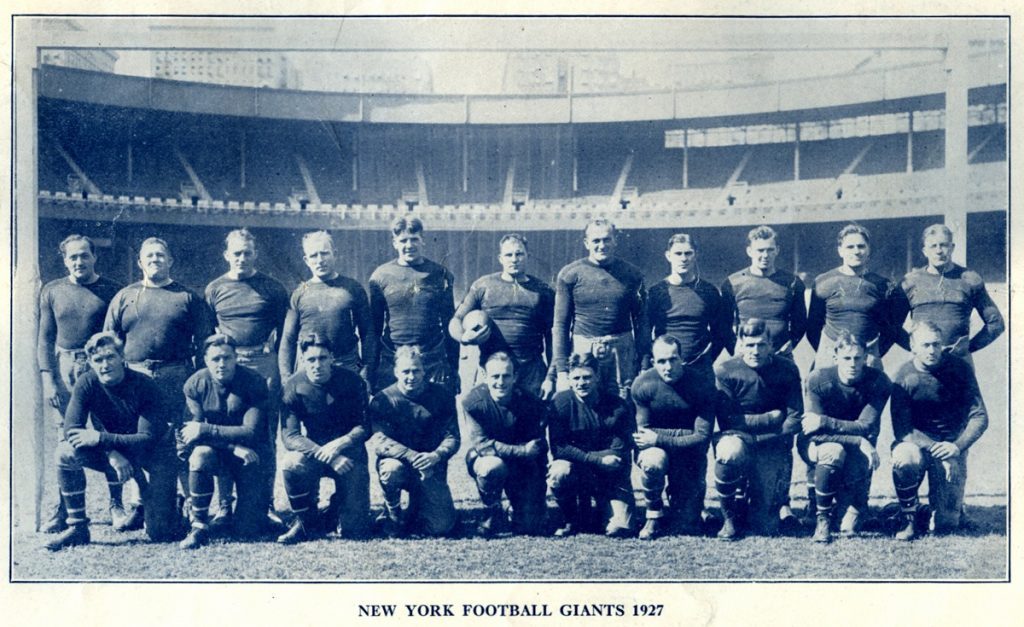
1927 New York Football Giants – Photo Courtesy of Rev. Mike Moran
[contentblock id=1 img=html.png]
The early attempts to organize professional football were no doubt sincere. But results were minimal. In hindsight, it’s easy to see that trial-and-error was the guiding principal for many of the organizational efforts by the nascent National Football League (NFL). Even its first name, the American Professional Football Association (APFA), required refinement. At least that was a quick-and-easy fix; many others were not.
APFA President Joe Carr (who served from 1921-39 and is known as the man who brought respectability to professional football) was quick and decisive to correct faults. His simple philosophy was the sport should always strive for the highest possible standards and the public should be considered first, last and always.
The lack of standardized player contracts, make-shift schedules and franchise instability were paramount issues that were gradually rectified over time. However, with no post-season play until 1933, the most public controversies were the ones that came after the close of each season (the end to each season being sometimes ambiguous itself) when more than one team claimed itself league champions. Four of the first six APFA/NFL titles were publically disputed, hurting the credibility of the pro game with a sporting public who clearly preferred the college game at the time.
It didn’t help any that the first controversy came after the APFA’s inaugural 1920 season. The lack of structure was astounding and nobody had the foresight to recognize that it was lacking. There were 14 teams stacked top-to-bottom, with a convoluted method of calculating win percentage (remarkably, the all-too-common ties were discounted); no coherent tie-breakers; unbalanced, makeshift schedules that teams modified during the season; and a lack of a clearly defined conclusion to the season. This was a recipe for disaster.
Even worse, most of the early championships were not awarded until an oft-contentious vote at the spring meetings, months after the last game had been played. The title outcome was inevitably anti-climactic.
A Litany of Confusion, Confrontation and Conspiracy
Intrigue surrounded the 1920 Championship as three teams claimed ownership of the title. It also illuminated the folly of treating tie games as non-entities.
The Akron Pros appeared atop the APFA with a record of 8-0-3. However, the unbalanced schedule saw two teams with more victories than Akron. The Decatur Staleys (soon to be known as the Chicago Bears) were second with a 10-1-2 record, and third were the Buffalo All-Americans at 9-1-1. Both challengers supported their bids by highlighting the fact that the Pros did not beat either of them, having played both to 0-0 ties.
Regardless, the vote at the April owners meeting went to Akron. Interestingly, applying the tie-breaker principle that was put in place in 1972 that calculates tie games as a half-win and half-loss, Akron and Buffalo would have tied for first place with a win percentage of 0.864 and Decatur third with 0.846. Buffalo and Decatur may have left dissatisfied, but this was nothing compared to what they would be embroiled in next season.
As the 1921 season was coming to a close, the renamed Chicago Staleys and Buffalo All-Americans found themselves in a fight for first place. They met on Thanksgiving Day with the All-Americans coming out on top 7-6. The win vaulted Buffalo to the top of the APFA standings with a 7-0-2 record and dropped Chicago to second at 6-1-0. Buffalo won their remaining two games to finish 9-0-2 and publically touted themselves as league champions. The Staleys played one more game against Green Bay, which they won, and finished their schedule at 7-1.
At this point, the Staleys owner-player-coach George Halas challenged Buffalo owner Frank McNeil to a rematch on his turf. McNeil accepted, but allegedly on the grounds that the game be treated as an exhibition contest. The 10-7 Chicago win served as a catalyst for turmoil. Now within a win of 9-1-2 Buffalo, Halas quickly scheduled two more games on his home field against Canton and the Chicago Cardinals, winning one and tying the other.
Halas successfully petitioned the league’s owners to award his 9-1-1 team the league crown. His claim was unique, and the ultimate decision at the April owners’ meetings set a significant precedent, despite McNeil’s objections. Halas argued not only that the aggregate score of the two Buffalo-Chicago contests (which favored the Bears 16-14) be taken into consideration, but that the second game be given more weight in that it had more importance being nearer the close of the season. The majority of owners decided that the outcome of the second head-to-head contest should carry more weight. That policy would remain through 1932.
Fortunately for Carr and the rest of the now renamed National Football League, the 1922 and 1923 seasons were without title dispute as player-coach Guy Chamberlin’s Canton Bulldogs trucked through the competition with nearly unscathed records of 10-0-2 and 11-0-1. Despite their on-field success, Canton struggled financially and suspended operations for the 1924 season.
Sam Deustch, owner of the Cleveland Indians franchise, quickly signed seven members of the Canton roster, including Chamberlin, and signed Michigan Wolverine passing sensation Benny Friedman after his college graduation. The bolstered Cleveland team, which included a late-season addition of tackle Steve Owen from the Kansas City Cowboys, defeated the Chicago Bears 16-14 in their opener and faced little competition the rest of the season, losing and tying the Frankford Yellow Jackets on their way to a 7-1-1 record. All of this factored into another convoluted, off-field fight to determine the league’s championship, but in this case to the betterment of the league’s reputation as a loop-hole would be closed in the process.
The league standings, at the still-ambiguous close of the 1924 season, stacked up in this order: Cleveland 7-1-1 (0.875 win percentage), Chicago 6-1-4 (0.857) and Frankford 11-2-1 (0.846). Halas attempted similar tactics that worked in his favor in 1921. After a Thanksgiving Day win boosted the Bears record to 5-1-4, he scheduled a game against the weak Milwaukee Badgers, which Chicago won 31-14, then challenged Cleveland to a rematch.
Carr stepped in and ruled that the schedule retroactively officially ended November 30. Teams were permitted to continue playing, but those contests would be rendered with an exhibition status and would not count in the official league standings. Cleveland was awarded the championship, Chamberlin’s third in a row.
The next season in 1925, another precedent was set, one which would significantly support the New York Giants tenuous franchise.
College football was still a significantly larger draw than professional football. The Pottsville Maroons and Frankford Yellow Jackets had an agreement that the better team in the region would host the Notre Dame All Stars in Philadelphia. The teams split their head-to-head games, but Pottsville’s 49-0 advantage in the second game and their better record was decisive. Frankford ostensibly believed Pottsville ran up the score in their landslide victory, and petitioned the league office that Pottsville hosting the game in Philadelphia was an infringement on their territory. To underscore their point, Frankford scheduled a game versus Cleveland at Frankford Stadium, which was just outside of Philadelphia, on the same date. Moving or cancelling the game would be a financial disaster the Maroons would not be able to absorb, as the All Stars would not appear for a game at Pottsville’s high school stadium at Minersville Park.
Carr sided with the plaintiff Yellow Jackets and telegrammed the Maroons to move or cancel the exhibition contest. Pottsville owner John Streigel declared his intent to still play the game. Streigel later said he received verbal permission from Carr to play the All Stars at Shibe Park, even though Carr issued two subsequent statements claiming the opposite.
Carr suspended Pottsville from the league immediately following the exhibition contest, and awarded their scheduled game at Providence on December 13 to Frankford. Nevertheless, Pottsville’s 10-2 record and convincing head-to-head win against the Chicago Cardinals paced them ahead of the 9-2-1 Cardinals. However since the league’s end date had been previously set at December 20, Cardinals owner Chris O’Brien scheduled two more home games against weaker teams to pad his team’s win total.
When the season finally ended on December 20, the top of the standings had the Cardinals in first at 11-2-1 and Pottsville 10-2-0. Pottsville was not represented at the owners meeting when the crown was given to the Cardinals since they were still barred from the league.
New York, New York
Given all that tumult, it is easy to forget that professional football finally placed a permanent foothold in the nation’s largest city, New York, which had been a part of Carr’s vision for long-term league success. Carr had originally envisioned boxing promoter Billy Gibson to be the founder, but he deferred instead to friend Tim Mara. Present at the meeting was also the football-knowledgeable Dr. Harry March. March had been vital in the success of the APFA/NFL’s predecessor, the Ohio League, where he had served as the team physician for the Canton Bulldogs. Mara took March on as a minority owner and installed him as team President to take charge of assembling a quality roster.
The Giants fared reasonably well for their first season of competition in 1925, finishing the year 8-4, but they struggled to attract paying customers. In fact, tickets for games at the Polo Grounds were routinely handed out free of charge to fill empty seats. It wasn’t until a visit from Illinois superstar Harold “Red” Grange, who had made the mid-season leap from college to the Chicago Bears, that the Giants could declare a profit and decide to move forward with their franchise. The possibility of the Giants dissolving after one season was very real, as nine other franchises had disbanded or left the NFL during or after their inaugural season of play.
The Polo Grounds seating capacity for football was normally around 55,000, but the demand to see the already legendary Grange was so irresistible that temporary seating was put in place in the outfield and standing room only tickets were issued. The gate was estimated to be in excess of 70,000 and photographs from the event support this claim. The only other time the Polo Grounds was that full was for the game against the Notre Dame All Stars in 1930. Not even the five post-season contests the Giants hosted in the Polo Grounds in later years against stalwart franchises Chicago, Green Bay and Washington had as many.
Irony reared its head just a few short months later when Grange’s manager, Charles C. Pyle, found a loophole in the contract with the Bears and signed Grange. Pyle prematurely leased Yankee Stadium before he even had a team. But Pyle had Grange so he had leverage. When Pyle approached Carr on the idea of expansion in New York, Mara and March balked. The prospect of having a team with Grange playing within walking distance of the Polo Grounds would spell the Giants doom. As tempting as it was to have Grange headlining the marquee in New York, Carr had no choice but to follow the precedent he’d set the prior season in the dispute between Frankford and Pottsville. Carr upheld Mara’s claim to having “exclusive right to anything in New York.” Being spurned but resolute, Pyle formed his own league to feature his star player, the first-ever American Football League (AFL).
This was now a league-wide threat for Carr and his constituents. The AFL attempted, and sometimes did, lure players from the established but still tenuous NFL. The Giants lost both their best lineman Century Milstead and head coach Robert Folwell to the upstart league. Part of Carr’s response to the new threat was to reinstate the Pottsville franchise, being fearful that team would sign with Pyle. Also, he forged an agreement with the Giants to allow a franchise in Brooklyn. Carr feared the AFL establishing two franchises in New York and wanted to beat them to the punch. He assured the Giants that the Brooklyn team’s schedule would not conflict with the Giants. This was keen foresight on Carr’s part, as the AFL then placed a franchise in nearby Newark, New Jersey. Just one year after having a single professional football team in New York, the metropolitan area now had four! The man most responsible for saving the Giants franchise in 1925, Red Grange, now threatened to render them irrelevant.
The 1926 season played out much like the one before for the Giants. Their 8-4-1 record was similar and so was their attendance. With no draw like Grange to fill the house and player salaries increasing with the competing league, the Giants finished in the red financially. They did win the war against Pyle however. Following the season, Mara and March hosted a game at Yankee Stadium against the AFL Champion Philadelphia Quakers. The motivated sixth-place Giants team manhandled the Quakers at the Polo Grounds 31-0, leaving no doubt as to which league was superior. Fortunately the crowning of the NFL champion was not business as usual. All was calm and everyone was in agreement when the title was bestowed upon Chamberlin’s 14-1-2 Frankford team. It was his fourth championship with his third team in only five seasons, a feat that has yet to be equaled.
Contraction and Contrition
The AFL disappeared just as quickly as it emerged. Although the Yankees drew well wherever they went, the rest of the league seemed to go unnoticed. The debts incurred by the NFL teams were a fraction of those compared to the ones suffered by the AFL. The Giants fortunes seemed to turn around quickly following that boastful triumph over the Quakers.
The dissolution of the nine-team AFL was a significant coup for the NFL, which had fielded 22 teams in 1926. The available talent was spread thin over the total of 31 teams in operation between the two leagues. A series of difficult ownership meetings that off season resulted in the contraction of the NFL. Gone were sentimental favorites with Ohio League roots like Canton, Akron, Hammond and Columbus. It was just not practical for the league’s survival to maintain franchises in locations lacking growth potential. For the NFL to become a big-time league it had to play in big-time cities, and having better players on those teams improved the quality of the product on the field.
The NFL would field 12 teams for the 1927 season. Ten were NFL survivors of the great purge of 1926, plus the return of the Cleveland Bulldogs following a year of suspended operations. Pyle’s Yankees team, which had the distinction of becoming the forty-first franchise in the APFA/NFL’s seventh season of operation, was the sole newcomer from the now-defunct AFL . The only small market team continuing on was publically-owned Green Bay.
Part of the consolidation directly benefitted the Giants. The Brooklyn Horsemen disbanded, but Carr kept its charter active. It was awarded to Mara as payment for unresolved debts. Soon after, Pyle returned to Carr’s office seeking admission to the NFL. This time Mara and March had no objections. Mara leased the former Brooklyn charter to Pyle, who would continue to feature Red Grange at Yankee Stadium. But the Football Yankees schedule would be tightly restricted. The Yankees would primarily be a traveling team, and their few home games would not coincide with Giants home games. Lastly, the season would end with a home-and-home competition for the City Championship.
With Pyle being reduced from threat to nuisance, the focus of the New York Giants was now on team building. Having less competition and a larger talent pool to select from, Mara confidently told March, “I don’t care what it costs but get the players you need. I want a winner this year.”
March’s vision was simple and the approach primal. After installing Earl Pottieger the Giants third head coach in just their third season, this Giants team would be built for power and control both sides of the line of scrimmage. The roster was composed mostly of veterans and was unusually deep; there would be little drop-off in performance when a sub was called upon.
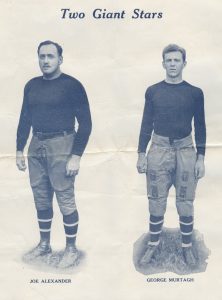
Joe Alexander and George Murtagh – Photo Courtesy of Rev. Mike Moran
Mickey Murtagh returned at center from the 1926 team. Hec Garvey and Al Nesser were well-traveled and experienced guards. Nesser was familiar to March as he was one of the seven famed Nesser brothers who played for Carr’s Columbus Panhandles in the Ohio League. They were professional football’s original “royal family” and their reputation was rock solid. Legendary Notre Dame Coach Knute Rockne competed against them as a member of the Massilon Tigers and famously stated, “Getting hit by a Nesser is like falling off a moving train.” Al brought championship experience, having been a member of the 1920 Akron Pros. Joe “Doc” Alexander, a remnant from the inaugural 1925 Giants, backed them up when available, as his medical practice demanded much of his time.
The left tackle was one of the largest and toughest players in all of professional football, Steve Owen. March brought Owen to the Giants the prior year after observing him as a member of the 1925 Kansas City Cowboys. The Cowboys had visited the Polo Grounds that season and later served as the Giants barnstorming team after the regular season. Owen was a man who relished having his hand in the dirt, “We were pretty much a smash and shove gang. We were bone crushers, not fancy Dans.” Wilbur “Pete” Henry, a member of the 1922 and 1923 champion Canton Bulldogs, served as the right tackle for the early portion of the season. The sub for Owen and Henry was Dick Stahlman.
The athletic Chuck Corgan, who had been a teammate of Owen in Kansas City, was a good receiving end. On the other side was the rookie wunderkind Cal Hubbard. At 6’4” and 245 pounds, he was the largest member of a team stocked with big men. But it was his unusual speed and agility that made him one-of-a-kind. He did more than just set the edge for end runs. Hubbard would routinely knock his counterpart on his back and continue his path of destruction downfield, springing Giant ball carriers for long gains. He was also a premier defender, patrolling the line of scrimmage as an end or prototype linebacker. His ascension to stardom was as brutal as it was quick. Wellington Mara recalled Hubbard years later, “You could tell when Cal hit a man. You would hear it on the bench – a hard, dull boom.”
The backfield may have lacked the notoriety of the group blocking for them, but it was talented and versatile. The mainstays were tailback Hinkey Haines and fullback Jack McBride, both members of the 1925 Giants. They complimented one-another with a blend of power and speed. McBride was the power back who bulled through the line while Haines rushed around the corner with elusiveness and speed. Atypical of the common trend though, the fullback McBride was the Giants primary passer, whereas the tailback for most teams performed that role. McBride was also the primary kicker, whether from a drop-kick or placement. The versatile Doug Wycoff subbed both positions. Mule Wilson was the lead blocking back, and he was backed up by Jack Hagerty, who was moved from the halfback position he’d played during the 1926 season. A veteran presence was provided by the former Ohio Leaguer Joe Guyon, who played multiple roles including wingback. Guyon had been a teammate of Jim Thorpe’s with the Canton Bulldogs in the Ohio League in 1919 and also with the NFL’s Oorang Indians in 1921 and 1922. Phil White served as a utility sub for halfback and fullback.
Power Football
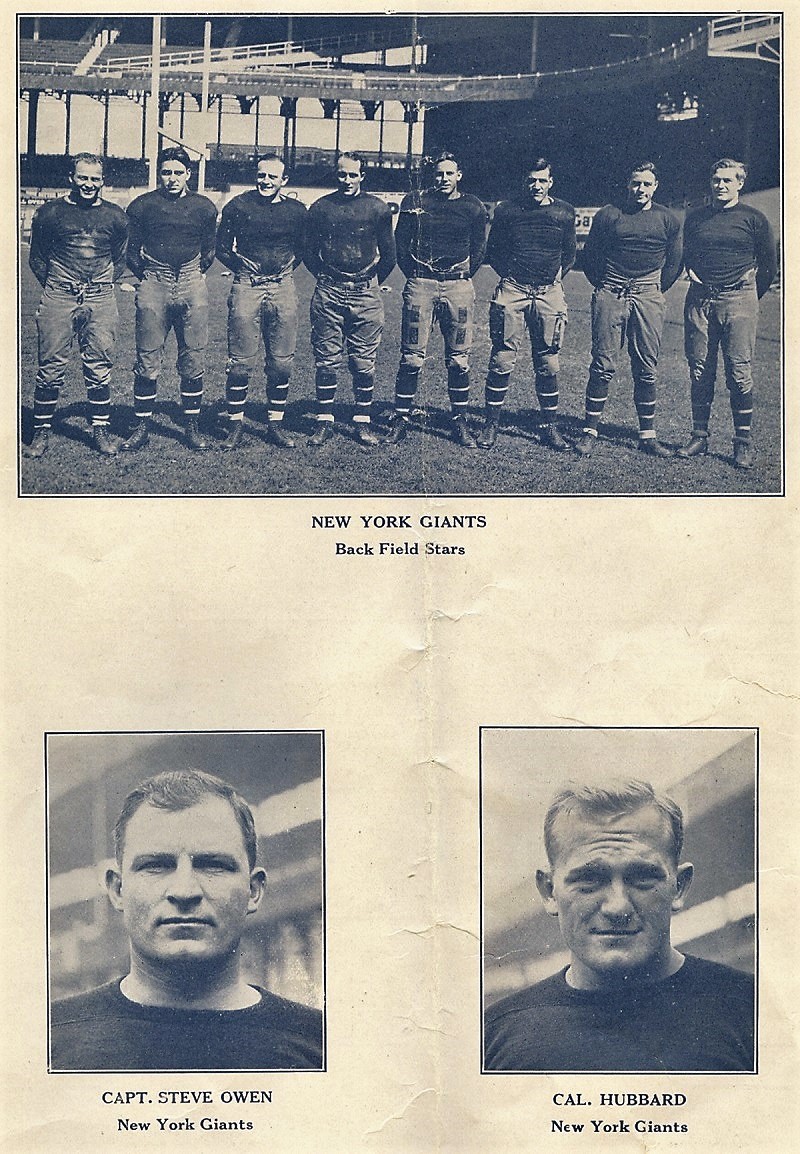
Steve Owen and Cal Hubbard – Photo Courtesy of Rev. Mike Moran
Following a dress rehearsal against the Orange Athletic Club, the Giants opened their regular-season campaign by disappointing 7,500 Providence fans with a stifling 8-0 victory over the Steam Roller. The local press lauded the Giants “great forward wall” and singled out Cal Hubbard, “He put on one of the greatest displays of line work ever seen on a Providence gridiron.” The rookie set up New York’s only touchdown by blocking a punt that Owen recovered at the Providence 2-yard line. Hubbard was also instrumental in limiting the home team to five first downs.
The defense continued its good work at Cleveland the following week, but the offense sputtered. It was surprising that only 3,000 fans attended given that it was their first opportunity to witness the home debut of rookie passing sensation Benny Friedman. Friedman moved the ball well but the Giants defense was stout when most needed. Doug Wycoff returned a punt 70 yards for New York, but the rest of the special teams performance was dreadful. The Giants missed five field goals and left Cleveland with a 0-0 tie.
Following a 19-0 win in front of 5,000 fans in Pottsville, where New York’s subs enjoyed plenty of second-half playing time, the Giants returned home to the Polo Grounds, unfortunately to second billing.
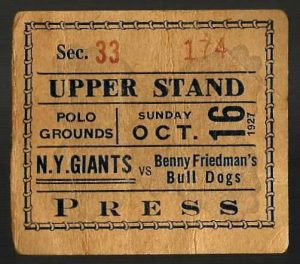 In the re-match against Cleveland, Friedman arrived several days ahead of his Bulldog teammates and was lavished with several honors, not the least of which was a gala event in his honor at the Hotel Majestic. Despite this being just his fourth professional game, he was easily one of the NFL’s marquis attractions among the likes of newsreel sensations Red Grange and Ernie Nevers. The Giants even printed the tickets for the game to read: “N.Y. Giants vs Benny Friedman’s Bulldogs”.
In the re-match against Cleveland, Friedman arrived several days ahead of his Bulldog teammates and was lavished with several honors, not the least of which was a gala event in his honor at the Hotel Majestic. Despite this being just his fourth professional game, he was easily one of the NFL’s marquis attractions among the likes of newsreel sensations Red Grange and Ernie Nevers. The Giants even printed the tickets for the game to read: “N.Y. Giants vs Benny Friedman’s Bulldogs”.
All of the pomp may seem excessive, but to his credit, Friedman lived up to the billing. Even as a rookie he was audacious in his play calling, throwing the ball on first down and from deep in his own territory when the common practice at the time would call for conservative line plunges or a punt. Although the crowd at the Polo Grounds was not nearly as large as the one to see Grange two years earlier, the Giants had to be pleased with the turnstile count of 25,000.
The Giants strong line controlled most of the first half, but the game was tied 0-0 at halftime after Jack McBride missed a field goal attempt. The third quarter began with an exchange of punts, then Cleveland’s speed got the better of New York’s muscle. Friedman connected on a 35-yard pass to Tiny Feather down to the Giants 30-yard line, followed by a 15-yard completion to Jim Simmons to the 14. Friedman and Simmons alternated rushes until Simmons went over for the score from the one-yard line. This was the only score of the game (Friedman was wide on his point-after attempt) and the first of the season yielded by the Giants. But Cleveland won the game 6-0 and the Giants fell to 2-1-1. Friedman ended the afternoon 11-17 passing, which was very respectable for the time and unheard of in a winning effort. Normally that many pass attempts came in desperate, come-from-behind situations.
Although New York fielded a quality team, something was amiss. Aside from the poor tackling exhibited in the second half of the loss to Cleveland, the running game on offense was sporadic. The Giants made a move by sending the powerful but slowing Pete Henry to Pottsville. They then signed Century Milstead, who was idle after a one-year hiatus with the rival AFL’s Philadelphia team. He had been the best lineman on New York’s 1925 team.
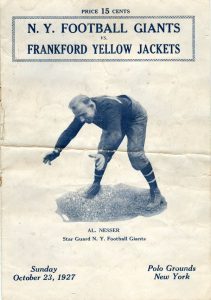
Al Nesser – Photo Courtesy of Rev. Mike Moran
The infusion of relative youth and tangible athleticism was appreciably noticed during a home-and-home weekend against the defending-champion Yellow Jackets. As was their custom, Frankford played their home games on Saturday as Sunday spectacles were prohibited by local blue laws. Often they would follow up a Saturday game at Frankford Stadium with an away game against the same team on Sunday. The rushing game was greatly improved, as the Philadelphia press cited Haines for “having an outstanding game” for New York in their 13-0 victory.
At the Polo Grounds rematch, a 20-point second quarter for New York was highlighted by a spectacular defensive play that brought the crowd of 15,000 to its feet. Jack Hagerty intercepted a pass at his own 47-yard line, sidestepped two Yellow Jackets, cut up-field, stiff-armed a would-be tackler along the sideline, and eluded several others until he was dragged down from behind at the 3-yard line for a 50-yard return. Phil White went over for the touchdown and the Giants subs held Frankford off the scoreboard in the second half to finish the 27-0 victory.
The following week saw a physical, altercation-filled scrum with Pottsville. The New York defense was dominant once again, registering a safety in a 16-0 win. The 20,000 Polo Grounds faithful must have been amused when a second safety was awarded after the Maroons punter had lined up beyond the end line to receive the snap despite several warnings to correct his position from the closest official.
The Giants played host to another of the NFL’s early stars the next week when Ernie Nevers arrived with his traveling Duluth Eskimos. They represented Duluth in name only, having played in the city only once in 1926. The Eskimos counted on lucrative visitor’s shares of the gate by playing an all-road schedule in large venues such as the Polo Grounds. The 15,000 who showed up may have been a mild disappointment to the Giants, but it was far more than Duluth could realistically hope for in northern Minnesota.
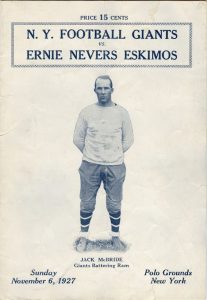
Jack McBride – Photo Courtesy of Rev. Mike Moran
Nevers was the second most famous player in the league after Grange, and some observers believed him to be of equal talent. Nevers was a triple threat on offense, played rock solid defense and could be counted on to play close to the full 60 minutes every game, occasionally completing the duration without a trip to the bench. Glenn “Pop” Warner, who coached Nevers at Stanford famously called him, “the football player without a fault.”
The Giants powerful defense did yield yardage to Nevers, who was cited by the press for giving “a strenuous effort,” but again refused to yield a point. The Eskimos penetrated the New York 30-yard line five times but came away empty. Three of those drives ended with interceptions while the other two saw them halted on downs. Jack McBride engineered three scoring drives for New York. The final one featured an exclamation-point 25-yard touchdown pass to Hinkey Haines to close out the 21-0 win.
At 6-1-1, the Giants may have been pleased with their place in the standings. But a three-way race with the Packers and Bears for the number one spot in the league made it clear that there was no time to rest on laurels. Tuesday was Election Day and the Providence Steam Roller was coming to the Polo Grounds, while on the other side of the Harlem River the Bears would be visiting their old teammate Red Grange and the Yankees. This would be Grange’s first game back after tearing a ligament in his knee at Cubs Park back in October, and it was the Yankees first home game of the season.
The Giants played in front of their largest house of the year; 38,000 fans showed up for a football triple header, as the Giants and Steam Roller played following two high school games. The headliners did not disappoint. The Giants capitalized on three big plays in all three phases of the game: Mule Wilson’s 54-yard interception return, Jack McBride’s 39-yard touchdown pass to Jack Hagerty and Hagerty’s 53-yard punt return. Most of the fans probably forgave the Giants for missing three of their four point-after attempts in the 25-0 victory after learning the rival Yankees, with a limping Grange, upset Chicago 26-6. End Ray Flaherty, who would join the Giants in 1928, starred for the Yankees that afternoon by hauling in three touchdown receptions. The Giants now held the top spot in the NFL and had the inside track to the championship if they could win out the rest of the way.
The Giants had next been scheduled to play the Buffalo Bisons, but the Bisons disbanded mid-season. Instead, the Giants played a non-league exhibition at Staten Island against the Stapletons. Showing no fear of travel or injury, the Giants then visited Boston to play another exhibition game against Pierre Marquette the Saturday before a crucial league contest against the Chicago Cardinals, who were now coached by Chamberlin. The Cardinals held no advantage as they played at Frankford on Saturday as well.
The Giants jumped all over the visiting Cardinals early, scoring three touchdowns in the game’s first 10 minutes. New York’s subs played to a stalemate as the Giants coasted to a critically important 28-7 victory that maintained their slim advantage over the Bears who were next on the docket. Chicago was in a second place tie with Green Bay, but both of the Packers losses were to the Bears so the Packers only hope for first place would be both teams above them collapsing.
Strength Versus Strength
Again, the Giants participated in a non-league exhibition at Staten Island the Thursday prior to their biggest game of the season. The 8-1-1 Giants knew owner-player-coach Halas would have his 7-2-1 Bears ready to go, as he had been in this situation many times before. A Chicago win would give the teams matching 8-2-1 records and the Bears a late-season head-to-head victory. Should both teams win out after that, history had already demonstrated Halas’ persuasiveness among the league’s owners in regard to championship votes. Ironically, the situation could even have been in reverse. In the event of a tie, the Giants would be the team in position to challenge the Bears to a rematch. Knowing the precedent set in 1921 with the Bears and Buffalo, would Halas have even accepted and risked a title he may have believed already belonged to him?
Were it not for miserable cold and the threat of snow, the crowd of 15,000 at the Polo Grounds probably would have been much larger, as the local press had well-publicized the significance of the game. Although no official NFL championship game yet existed, this was as close to it as you could get. The winner in all likelihood would end up being crowned champion, even if they had to wait until April for it to be declared official!
If any team were capable of matching the Giants on the line of scrimmage it was the Bears. They had two future Hall of Famers at the tackle positions: Link Lyman and Ed Healy. Center George Trafton was an All-Pro. The backfield featured future Hall of Fame halfback Paddy Driscoll and tailback/quarterback Dutch Sternaman. Sternaman co-coached the Bears with Halas.
The Bears front line asserted itself early. After receiving the opening kickoff, Chicago pounded away at New York’s defense, moving the chains until facing a first-and-goal at the 8-yard line. Three line plunges set the Bears up with fourth-and-goal on the one. Halas wanted six and ordered Sternaman to go for it. Fullback Jack White took the ball on a handoff, but as he attempted to vault over the wall of crashing bodies, White was hammered in mid-air and knocked backward by Al Nesser.
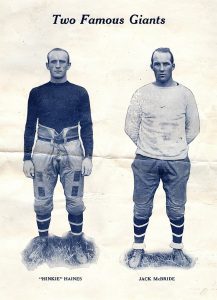
Hinkey Haines and Jack McBride – Photo Courtesy of Rev. Mike Moran
The scoring threat was thwarted, but New York was still in trouble. Not surprising for the era, the Giants lined up in punt formation of first down. Mule Wilson was deep to receive the snap. The up-back Hinkey Haines cautioned him to line up correctly with his heels in front of the end line, recalling the incident with Pottsville’s punt several weeks earlier, and requested that the referee wipe mud off of the ball with a towel for a more accurate snap. Chicago realized the predicament the Giants were in and jammed nine men on the line of scrimmage. While the official wiped the ball down, Haines discreetly deepened his position a few steps and surveyed Chicago’s deployment as he called the signals. Haines received a direct snap and lofted a perfect pass to Chuck Corgan over the unguarded middle. The Bears had only two men deep and did not take Corgan down until he had advanced beyond midfield to Chicago’s 41-yard line.
Although the Bears kept the Giants off of the scoreboard, the stunning 58-yard play not only tipped the field position back to the Giants favor, it also quelled the surge of momentum the Bears had in their favor with the long opening drive. The action largely took place around mid-field for the remainder of the first half with the teams exchanging punts. At the half, the game was deadlocked 0-0.
The third quarter began much the same way, but the Giants received a jolt in an unlikely fashion. On the Giants second possession of the half, Halas attempted to clip Joe Guyon. Guyon had heard him coming though. As Halas launched himself, Guyon pivoted and rammed his knees into Hala’s chest, sending him to cold turf breathless. As Halas was helped off the field with two broken ribs, Guyon slyly told his Giants captain Steve Owen, “That fellow ought to know you can’t sneak up behind an Indian.”
The ensuing 15-yard penalty on Halas was the spark New York had been looking for. Jack McBride punctured the Chicago front for a total of 53-yards on the 60-yard drive and went over for the touchdown from the two on a fourth-and-goal. The point-after was missed so the score held at 6-0. Another exchange of punts had the Bears pinned on their own two, and a poor punt only moved the ball out to the 30. McBride mixed runs with passes. Three line plunges from goal-to-go gave him his second touchdown of the quarter. And this time the point-after was good. The Giants led 13-0 as the quarter came to an end.
Undeterred, Driscoll took the Bears down the field as he did to start the game. Noticing that the New York front seemed to be growing fatigued, Sternaman kept calling for rushes as Chicago pushed and pounded the ball to the Giants 10-yard line. Here the Bears reached deep into their playbook and changed up their strategy entirely, lining up in a spread formation. Sternaman caught a pass from Laurie Walquist and darted into the end zone. The point after was good and the lead was trimmed to 13-7.
The concluding 10 minutes of action was fierce and physical, both powerful lines traded blows but neither offense could advance until Chicago’s last possession. A trade of punts preceded a last valiant effort by the Bears. The Chicago running game found a few creases and moved into New York territory with the clock running after each carry. The tiring Giant defense was bending and Chicago had the ball on the 17-yard line. Perhaps feeling a sense of desperation with the clock now just under 2:00 or recalling how the Bears last scoring drive ended, Sternaman called the first pass play of the possession. Mule Wilson made the play for New York and intercepted the throw. The Giants ran three plays to run out the clock. The chilled crowd celebrated the thrilling win, but the victors and losers were too spent to react.
“It was the hardest game any of us ever played,” said Steve Owen. “I played sixty minutes at tackle opposite Jim McMillen, who later became a world wrestling champion. When the gun ended the exhausting game, both of us just sat on the ground in the middle of the field. He smiled in a tired way, reached over to me, and we shook hands. We didn’t say a word; we couldn’t. It was fully five minutes before we got up to go to the dressing room.”
Once inside the locker-room, little changed. Hinkey Haines described the ironic scene, “That victory just about gave us the championship, but you’d have thought we all were just given walking papers.”
March tended to his battered victors, “Some of them looked like they’d never walk again.”
The key plays in the first quarter still reverberated. “Al Nesser (who stopped the Bears on fourth-and-goal from the one) was the real hero,” said Century Milstead. “Bare-headed and with no shoulder guards, he just kept submarining their running plays. He was battered but he never quit.” Owen complimented the selling of the fake punt, “Haines called one of the smartest plays I’ve ever seen to win for us. He stage-managed it perfectly.”
The New York Times led off the Monday game summary superlatively: “The Giants powerful forward wall met their equal in the Chicago Bears’ line yesterday and the battle that ensued was one of the most brilliant and savagely fought in the three years of professional football in New York…The play was spirited through sixty minutes of action, both elevens traveling at a fast and furious pace.”
The New York Daily News singled out the Giants touchdown maker: “Jack McBride was the outstanding figure in this grim grid struggle, counting both Giant touchdowns in a wild burst of ground spurning in the third quarter after the first half had been scoreless.”
Settling One Final Score
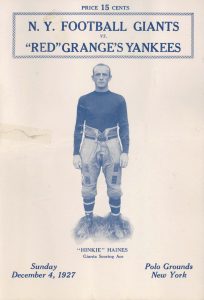
Hinkey Haines – Photo Courtesy of Rev. Mike Moran
The Giants truly needed the full week off following their most important triumph in the franchise’s short history. They must have been relieved to not have any exhibition contests interrupt their recovery. The season-ending home-and-home matches with their neighboring Yankees were most likely anti-climactic for most observers. But there is no doubt some within the Giants organization relished watching “arrogance being humbled” first hand as the Giants swept Pyle’s team 14-0 and 13-0 in miserable weather in front of small crowds. Babe Ruth and Lou Gehrig were among the 10,000 fans who braved the snow and sleet to watch the first game at the Polo Grounds in support of Grange’s team. Haines quickly dampened any enthusiasm they may have brought as he returned a first quarter punt 75 yards for a touchdown. Only 8,000 came through the turnstiles the following week to watch the two teams slosh around in the Yankee Stadium mud. Ball handling was treacherous in a fumble-filled contest. Joe Guyon was a featured ball carrier in these two games and contributed significantly to both Giants victories.
To his credit, Grange’s heart was stronger than his damaged knee. He played as long as he could and suffered a beating as the Giants repeatedly gang-tackled him after short gains. He hung tough, finished the first game and came out late in the second only after the outcome had been decided. Unfortunately the fans chose to express their disappointment in his performance by booing him, despite the fact he was the Yankees leading passer and had several good punt returns.
A Team For The Ages
It was a relatively inglorious end to an 11-1-1 season that had been anything but that. Yardage statistics from the 1920’s and early ‘30’s are sketchy. Some beat writers compiled such stats for the teams they covered, as did some teams. Over the years, historians have attempted to make calculations from news stories, but all such attempts are fragmentary and therefore not officially recognized. Jack McBride may have led the Giants in both passing and rushing in 1927. There is no doubt he led the Giants in passing yardage by a wide margin; the rushing total could be up for debate. He and Hinkey Haines carried the ball close to the same number of times. Given Haines’ break–away ability, a missing long gainer or two could easily tip the scale in his favor.
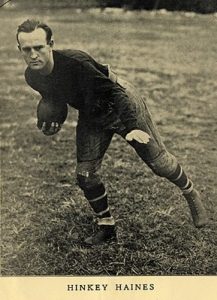
Hinkey Haines, New York Giants (1927)
Scoring records are reliable though. McBride led the NFL in rushing touchdowns with six. Including his two field goals and league-leading 15 point-afters, McBride also led the NFL in total scoring. McBride finished second (behind Friedman) in touchdown passes with six. His favorite target on scoring plays was Haines, who finished tied for first in the NFL with Ray Flaherty with four scoring receptions.
The post-season accolades, albeit diverse and unofficial, were abundant and adulatory. Various media outlets that covered professional football would comprise their own All Pro-style lists of players after each season. Not surprisingly, the most consistent over the early years was the daily paper from the football-crazed town of northern Wisconsin, The Green Bay Press-Gazette.
New York Giants who appeared on more than one first team list included: Cal Hubbard, End; Steve Owen, Tackle (though sometimes on these lists he was slotted in the Guard position); Jack McBride, Fullback (surprisingly usurping the great Ernie Nevers on occasion here); and Al Nesser, Guard.
Of course, the ultimate personal recognition is receiving a bronze bust in Canton, Ohio. Four members of the 1927 Giants have their likeness on display there for future generations of fans to admire: Steve Owen, Cal Hubbard, Joe Guyon and Wilbur “Pete” Henry.
In terms of perpetuity, New York set a record that realistically is not likely ever to be broken: the Giants shut out 10 of their 13 opponents, surpassing the nine shutouts by the Canton Bulldogs in 1922. Cumulatively, the Giants only gave up 20 points all season (Canton only gave up 15 points over 12 games in 1922).
The legacy of the 1927 Giants was power and control at the line of scrimmage. They were built to succeed in an era where the rules and equipment demanded conservative play in battles of field position. The few times New York exhibited weakness was when encountering speed (the two games they failed to win were the loss and tie against Friedman’s Bulldogs) and when they were spread horizontally (the touchdown they surrendered against the Bears.) After he retired, Red Grange summed up the 1927 champions succinctly: “It was the best football team of its time. Their line beat the hell out of you and wore you down, and their backs could move the ball. But they would have been passed off the field by the top teams of the 30’s.”
